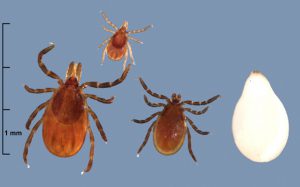
The Immunodiagnostics/Parasitology Section offers PCR and Indirect Fluorescent Antibody Titer (IFA) assays for detection of arthropod-borne organisms that infect companion animals, livestock, and wildlife. Most of our PCR assays detect organisms at the genus level, for example, Anaplasma spp. instead of a specific organism (Anaplasma phagocytophilum). Our IFA assays provide an antibody titer; not just a positive or negative result.

Recommended Tests
Arthropod-borne PCR assays include:
- Anaplasma marginale, centrali, phagocytophilum, and platys
- Babesia canis, gibsoni, bigemina, ovis and odocoilei
- Bartonella henselae, clarridgeiae, elizabethae, vinsonii, taylorii, quintana, and koehlerae
- Borrelia burgdorferi
- Ehrlichia canis, muris, ewingii, chafeensis
- Mycoplasma haemofelis, haemominutum, turicensis, haemocanis, haematoparvum, and haemolamae
- Neorickettsia risticii
- Rickettsia spp (spotted fever group)
- Eastern Equine Encephalitis virus
- West Nile virus
- Epizootic Hemorrhagic Disease virus
- Bluetongue virus
Many of the PCR assays can be done using formalin fixed tissue (check with the laboratory before sending fixed tissue).
Our IFA assays detect antibody against:
- Anaplasma phagocytophilum
- Babesia canis
- Babesia gibsoni
- Borrelia burgdorferi
- Leishmania donovani/infantum
- Neorickettsia risticii
- Rickettsia rickettsii
Tick-borne disease antibody panels are available for dogs and horses.
Collecting and Submitting Samples
Collection protocol, sample type, minimum volume, shipping information, price, turnaround time, and other additional information are provided for each test in our catalog. Please see the catalog for more details.
Please call us at 517.353.1683 and ask to speak to the Immunodiagnostics/Parasitology section if you need help ordering a test.
Client Education Resource Available
Use our guide on ticks and tick-borne diseases for clinicians and pet owners to help educate your clients about ticks and animal health.
All tick photos courtesy of Kent Loeffler, Department of Plant Pathology & Plant-Microbe Biology, Cornell University
